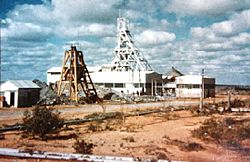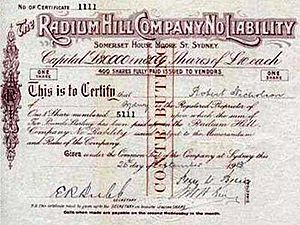Radium Hill facts for kids

Radium Hill minesite c.1954
|
|
| Location | |
|---|---|
| Location | 460 km North East of Adelaide and 110 km South West of Broken Hill |
| State | South Australia |
| Country | Australia |
| Coordinates | 32°20′45.97″S 140°38′11.64″E / 32.3461028°S 140.6365667°E |
| Production | |
| Products | Davidite, Carnotite, Uranium |
| History | |
| Opened | 1906 |
| Closed | 1961 |
| Owner | |
| Company | abandoned |
| Year of acquisition | first pegged 1906 |
Radium Hill is a former mine in South Australia. It operated from 1906 until 1961. This mine was Australia's very first uranium mine. Other big uranium mines opened much later. For example, Rum Jungle in the Northern Territory opened in 1950. The Mary Kathleen mine in Queensland opened in 1958.
A town grew up around the Radium Hill mine. It once had about 1,100 people living there. Now, it is a ghost town. Most buildings have been left or pulled down. The old town and cemetery were added to the South Australian Heritage Register in 2016. Between 1954 and 1961, the mine produced almost 1 million tonnes of rock. This rock contained a mineral called davidite. From this, they made about 860 tons of U3O8, which is a form of uranium.
Contents
History of the Mine
Discovery of Radium Hill
The Radium Hill site was first marked for mining in 1906. A prospector named Arthur John Smith found a special rock. He was about 40 km east of Olary. Smith thought the dark rock was tin oxide or wolfram.
He sent his rock samples to the University of Adelaide. A young geologist named Douglas Mawson studied them. Mawson later became a famous Antarctic explorer. He found that the rock had radium and uranium in it. It also had small amounts of other minerals. These included ilmenite, rutile, and magnetite.
Mawson named the uranium mineral davidite. He named it after another geologist and Antarctic explorer, Sir Edgeworth David. At first, the mine was called "Smith's Carnotite Mine." Carnotite is a similar uranium mineral. In September 1906, Mawson suggested the name "Radium Hill."
Smith worked the mine for two years. Then, he let his mining rights end. Other mining areas stretched for 5 km nearby. Mawson owned half of one of these areas.
Early Mining and Radium Production
The Radium Hill Company took over the mine in 1908. They dug more shafts into the ground. The rock they dug up was sent to special factories. These factories were in New South Wales and Victoria.
In 1911, radium was very valuable. One gram of radium cost £13,000. That same year, the company built a factory in Hunters Hill in New South Wales. This factory cost £15,000. It was built to make radium products.
The factory produced 350 milligrams of radium bromide (RaBr2). It also made 150 kg of uranium. The radium bromide was used for new studies. These studies were about radiation and radioactivity. Some of the radium was sold to famous scientists. These included Ernest Rutherford and Marie Curie.
Mining stopped at Radium Hill in 1914. The Hunters Hill factory closed the next year.
Second Phase of Operations
The mine started working again in 1923. The Radium and Rare Earth Treatment Company N.L. ran it. They continued mining until 1931. This company also built a processing plant in 1923. It was at Dry Creek, near Adelaide.
This plant made radium bromide for medical uses. But it was too expensive to run. Both the mine and the plant closed by 1932.
Uranium Mining for Defence
Activity at Radium Hill began again after World War II. The Department of Mines looked at the area in 1944. They did more exploration and drilling in 1946–1947.
In March 1952, the Australian and South Australian governments signed a deal. They agreed to supply uranium to the UK and USA. This uranium was mainly for defence. The deal was for seven years.
A part of Maldorkey Station was made into a "Uranium mining reserve" in 1954. The mine officially opened on November 10, 1954. The Governor General of Australia, Field Marshal Sir William Slim, opened it.
Building the Town and Infrastructure
The state government ran the mine. They built many things to support it. An 18 km spur line was built in 1954. This railway connected the mine to the main Broken Hill railway line. An aerodrome (small airport) was also built. Roads were made better too.
A town was built for the mine workers and their families. It had 145 houses. In 1961, 867 people lived there. The town also had a hospital and a school. There was a government shop, canteens, and a swimming pool. A bus service went to Broken Hill. There were also places for fun and shopping.
Mine Operations and Closure
The main shaft of the mine was 420 m deep. It had a 40 m tall structure called a headframe above it. The rock from the mine was crushed. This happened at a ball mill. Then it was treated at a special plant on the surface.
The treated material was sent by train. It went to the Port Pirie Uranium Treatment Complex. This complex was built just for this purpose. It processed rock from Radium Hill and another mine. The Port Pirie complex was also run by the state government.
The mine produced 970,000 tonnes of rock. This rock had 0.09-0.13% uranium ore. The processed material made about 150,000 tonnes of yellowcake. This yellowcake was then processed at Port Pirie. There, it was treated with hot acid. This made about 860 tons of U3O8. This was worth more than £15 million.
After seven years, the supply deal was finished. The mine officially closed on December 21, 1961.
Site Rehabilitation and Safety
Cleaning Up the Site
Work to clean up the site started in 1962. More work was done in 1981. The area where waste materials were stored was covered. About 75,000 cubic meters of soil were used. This soil came from nearby areas. Old mine openings were also filled in.
Radioactive Waste Storage
From 1981, a part of the site was used to store low-level radioactive waste. About 16 separate loads of waste were brought there. This included soil that was contaminated from Thebarton in Adelaide. The last waste was put there in 1998.
It is important to manage sites like Radium Hill carefully. This is because radioactive materials can be harmful. A study in 1979 looked at former Radium Hill workers. It found that some workers had health problems. This shows why safety is very important when working with such materials.
The site has not been active since 1998. The government department in charge of minerals still looks after the site. They keep a close watch on the radiation levels there.
Quotes
" That one ounce of it is equal to one hundred thousand nominal horsepower, and that small quantity would be sufficient to drive or propel three of the largest battle ships afloat for a period of two thousand years; ...It will mean that foreign nations will be obliged to seek from us the power wherewith to heat and light their cities, and find means of defence and offence.."



